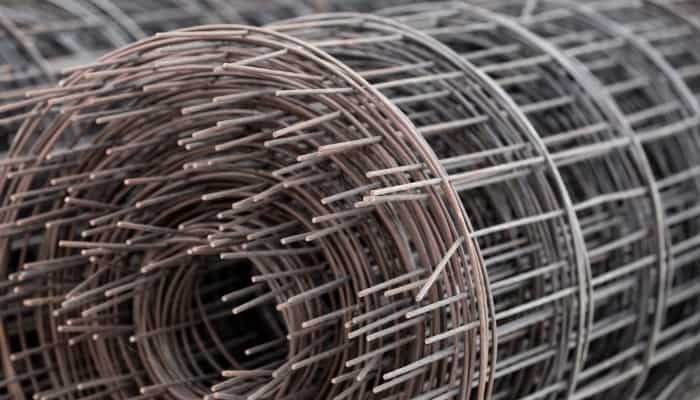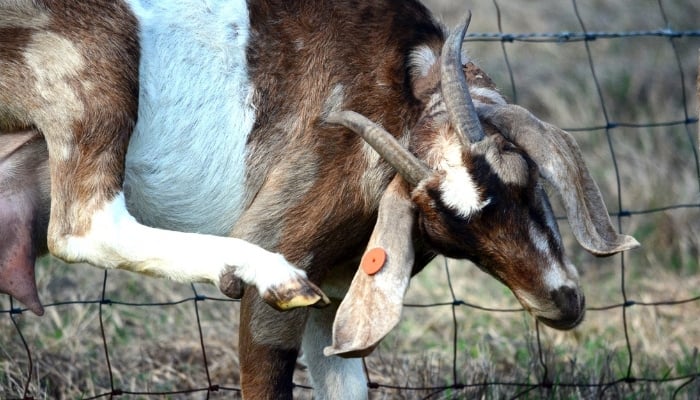If you’re considering using mesh wire, you have the choice between two options: woven wire or welded wire. Both have different uses, benefits, and limitations.
What’s the difference between woven wire and welded wire? Woven wire is pieces of interlacing wire woven together to create a flexible mesh that you can use for fencing pasture meant for large livestock animals. Welded wire is heavy-duty mesh welded at the cross sections making it sturdier and more durable than woven wire.
When deciding between flexible woven wire and heavy-duty welded wire, the choice isn’t always clear. Read more to find out when to use each type of mesh wire and how best to use it.
Woven Wire
Woven wire, as the name implies, is a series of metal wires interlocked according to a certain pattern to create a mesh sheet with a specific opening size, weave patterns, and wire diameter.
Woven wire is easy to customize during the weaving process to suit different needs.
What Is Woven Wire Fencing?
Woven wire fencing is a fence made of woven wire. It is quite flexible and easy to bend, reshape, twist, and pull.
The fence doesn’t break under pressure and can handle strong winds or water currents without breaking. This makes it ideal for filtration processes as well as gardening work.
It’s also the right wire fencing to use in pastures to contain livestock.
Types of Woven Wire
Despite the many designs and weave patterns available in the market, woven wire fences can be categorized in these three broad categories.
- Plain Wire Mesh: One of the simplest woven wire fences. It follows a basic weave pattern of over-and-under interlacing warp wire and fill wire. The end result is a fence with a smooth appearance and surface.
- Lock Crimp Wire Mesh: This woven wire follows the same weave design of over and under that is similar to the plain wire mesh but with a twist. At each intersection, the over wire pinches around the under wire to form a lock. These little bumps make the fence more rigid and secure.
- Intercrimp Wire Mesh: This mesh builds on the locking system of the lock-crimp wire mesh with an added bump in between the intersections. These crimps not only make the fence more sturdy but also give it a more appealing visual effect.
Woven Wire Gauges
Woven wire gauges are used to determine the size and wire diameter of the fence. It’s a technical categorization system used by industry workers and those who work with fencing and wire routinely.
The gauges use whole numbers such as 1, 2, 3, etc. The lower the gauge number, the thicker the wire. For example, gauge 7 is equal to 0.1770 inches, and 14 gauge is 0.080 inches.
However, there are four wire gauge systems. These are British, Stubs, American Wire Gauge, and Washburn & Moen. Each system has a different dimension for each gauge.
What Is Woven Wire Good For?
You can use woven wire on large pastures or in small gardens and farms.
It’s ideal for controlling livestock and large animals since it’s highly visible and poses little risk to the animals themselves.
There’s little risk of tripping over it or trying to break out of the enclosure.
You can also use it on small farms for smaller animals such as chickens, rabbits, and goats. The flexible mesh allows you to reshape it and bend it any way you like without breaking it.
Advantages of Using Woven Wire
The two main advantages of woven wire are strength and durability. It doesn’t break easily since the interlocking wires can move slightly against the wind, water currents, or any other physical pressure.
It’s also quite flexible, which comes in handy when you want to create a secure pasture fence or set up a makeshift protection fence for small plants.
Woven Wire Disadvantages
Woven wire is quite expensive compared to other types of mesh. The intricate weaving and interlacing come at a cost.
Another disadvantage is the need for level ground to install it. If the ground is not level, the mesh fence will have gaps that allow small predators in and out easily.
Welded Wire

Welded wire is a steel wire mesh made by welding the intersections of the wire pieces. There’s no flexibility in the wire openings and the welded wire sheet is more solid than its woven wire counterpart.
What Is Welded Wire Fencing?
Welded wire fencing uses sheets of welded wire to create a rigid and firm enclosure. It’s a less costly option for smaller spaces such as dog runs, chicken coops, and animal cages.
Types of Welded Wire
Welded wire comes in three main types.
- PVC Welded Wire Mesh: This welded wire mesh is coated with PVC powder. This protects the mesh against erosion and rust. It also gives the mesh a different color.
- Galvanized Welded Wire Mesh: This mesh is submerged into molten zinc to seal the surface and protect it against corrosion. It can be galvanized either before (GBW) or after welding GAW).
- Welded Stainless Steel Wire Mesh: This stainless steel mesh is more durable and has a uniform look. It’s also the most expensive of the three welded mesh types.
Welded Wire Gauges
Welded wire gauges are similar to woven wire gauges. Commonly used gauges range from 8.5 to 27.
What Is Welded Wire Good For?
Welded wire is a strong and cost-effective way to enclose gardens and other similar areas. It’s also ideal for constructing chicken coops and housing for small animals such as rabbits.
It doesn’t unravel if a few wires are broken, and it can stand up to a strong wind.
Advantages of Using Welded Wire
Many people prefer to use welded wire over woven wire. A woven wire mesh will unravel or weaken easily if one or more wires in the mesh are broken.
Welded wire, however, maintains its integrity and is easy to weld back if a few wires are damaged.
Welded Wire Disadvantages
Welded wire fences are not easy to shape or bend compared to woven wire. They’re solid, which can make it slightly more difficult to bend into specific shapes.
Best Applications for Woven Wire
You can use woven wire for enclosing fields and pastures. It is quite easy to stretch tightly between fence posts, and it does a great job of securing large animals.
It can be used to enclose gardens, but the large openings in the wire will not be very effective for keeping out small critters like rabbits.
Best Applications for Welded Wire
Although less flexible and not easier to reshape, welded wire has many applications in different industries.
It’s used widely in the keeping of poultry and livestock, mining, protecting structures, farming, safety enclosures, decorations, construction, and transportation among others.
Related Questions:
How Long Does a Woven Wire Fence Last?
A good quality woven wire fence that is installed properly can last for up to 50 years with the right maintenance and care.
Although made of metal, the woven wire fence can fall into disrepair and damage, which can shorten its life.
How Tall Should Fences Be for Livestock?
Due to their large size, cattle and other livestock need a fence that’s at least 4 feet high. The bottom of the fence should be no more than 18 inches from the ground.
Conclusion
When it comes to having a fence, both woven wire and welded wire meshes have their advantages.
Welded wire fences are more cost-effective and sturdy. They maintain their integrity even when a few wires are broken.
However, woven wire meshes are more malleable and are ideal for enclosing pastures.

